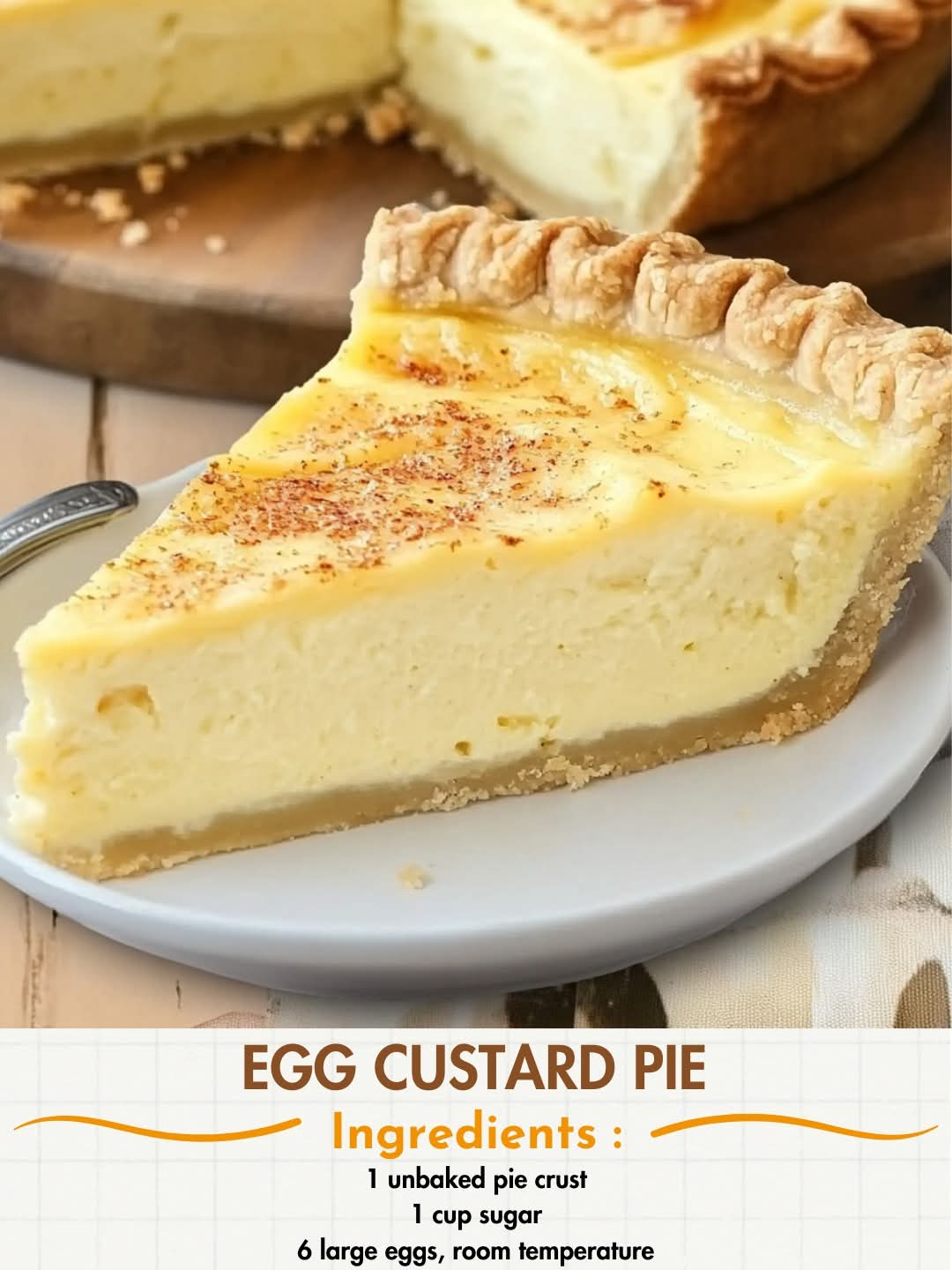Certainly! Here’s a comprehensive, long-form recipe for a classic Egg Custard Pie, complete with history, method, cultural context, and romantic notions of its culinary charm. Let’s go deep into this beloved dessert.
Egg Custard Pie: A Timeless Classic of Comfort and Charm
Introduction
Egg Custard Pie is a tender, silky dessert that whispers of nostalgia and timelessness. With a golden, flaky crust and a smooth, delicate custard filling, it is the kind of pie that reminds many of grandmother’s kitchen, Sunday suppers, and warm conversations over steaming coffee. Loved across generations and continents, Egg Custard Pie represents more than flavor—it speaks to home, tradition, and quiet romance.
History & Cultural Significance
The origins of custard date back to ancient Rome, where eggs were used to thicken sauces and form early versions of sweetened dishes. As culinary techniques spread through Europe during the Middle Ages, custards—both savory and sweet—found their way into tarts and pies.
In England, custard pies gained popularity during the Tudor period and were often served at royal banquets. Early American settlers brought these recipes with them, adapting them to local ingredients. The Southern United States, known for its comforting and heritage-rich cooking, embraced Egg Custard Pie, often calling it “Chess Pie’s silkier cousin.”
Over time, this pie became a staple in diners, church gatherings, and family reunions, cherished for its simplicity and elegance.
Ingredients
For the Pie Crust:
- 1 ¼ cups all-purpose flour
- ½ teaspoon salt
- ½ cup (1 stick) unsalted butter, chilled and cut into cubes
- 3–4 tablespoons ice-cold water
(Or use 1 unbaked store-bought pie crust for convenience.)
For the Custard Filling:
- 1 cup granulated sugar
- 6 large eggs, room temperature
- 2 ½ cups whole milk, warm
- 1 teaspoon pure vanilla extract
- ½ teaspoon ground nutmeg (plus more for dusting)
- ¼ teaspoon salt
Utensils You’ll Need
- Mixing bowls
- Whisk
- Rolling pin (if making crust by hand)
- 9-inch pie plate
- Baking sheet
- Sieve (optional, for extra-smooth custard)
- Aluminum foil or pie shield
Method: The Art of Egg Custard Pie
Step 1: Prepare the Pie Crust
- Make the Dough (if homemade):
In a large bowl, combine flour and salt. Cut in the butter using a pastry cutter or fingers until the mixture resembles coarse crumbs. Slowly drizzle in cold water, one tablespoon at a time, mixing until the dough just comes together. - Chill:
Form into a disk, wrap in plastic, and refrigerate for at least 30 minutes. - Roll & Shape:
On a lightly floured surface, roll out the dough into a 12-inch circle. Carefully transfer it to a 9-inch pie plate. Trim edges and crimp as desired. Chill while preparing filling.
(Skip to filling if using pre-made crust.)
Step 2: Make the Custard Filling
- Preheat oven to 375°F (190°C). Place a rack in the center of the oven.
- Whisk Ingredients:
In a large bowl, whisk together sugar and eggs until pale and smooth. Gradually whisk in the warm milk, vanilla, nutmeg, and salt. - Strain for Smoothness (Optional):
Pour the mixture through a fine-mesh sieve to remove any curdled bits or foam, ensuring a silky texture.
Step 3: Assemble & Bake
- Pour Filling:
Carefully pour the custard into the prepared crust. Place the pie on a baking sheet to catch any spills. - Bake:
Bake for 45–55 minutes, or until the edges are set and the center jiggles slightly when tapped. If the crust browns too quickly, cover edges with foil or a pie shield. - Cool:
Let the pie cool completely at room temperature. The custard will continue to set as it cools. - Chill (Optional):
For a firmer texture, refrigerate for 2–4 hours before serving.
Serving Suggestions:
- Dust lightly with extra nutmeg or cinnamon.
- Serve with whipped cream or fresh berries.
- Enjoy with hot tea, coffee, or a dessert wine.
Formation: What Makes It Special?
Egg Custard Pie is about balance. The formation of its delicate filling relies on a gentle interaction between egg proteins and milk fats. The slow baking process creates a structure that’s both firm and yielding, cradled by a crisp, buttery crust. Its simplicity allows the eggs, sugar, and vanilla to shine, forming a harmony that is neither too rich nor too sweet.
Lovers of Egg Custard Pie
This pie is for the romantic and the minimalist. Lovers of Egg Custard Pie often treasure tradition, believe in quiet elegance, and value recipes passed through hands and hearts. Whether enjoyed warm from the oven or chilled with afternoon tea, this pie has found a devoted following—from Southern grannies to Michelin-star chefs who reinvent it in delicate tartlets.
Conclusion
Egg Custard Pie isn’t just a dessert—it’s a culinary heirloom. It bridges the old and the new, the simple and the sophisticated. Whether you’re serving it at a family gathering, offering a slice to a loved one, or savoring it quietly at midnight, this pie promises comfort, connection, and contentment.
Would you like a printable version or a romantic story involving the pie as a centerpiece?
